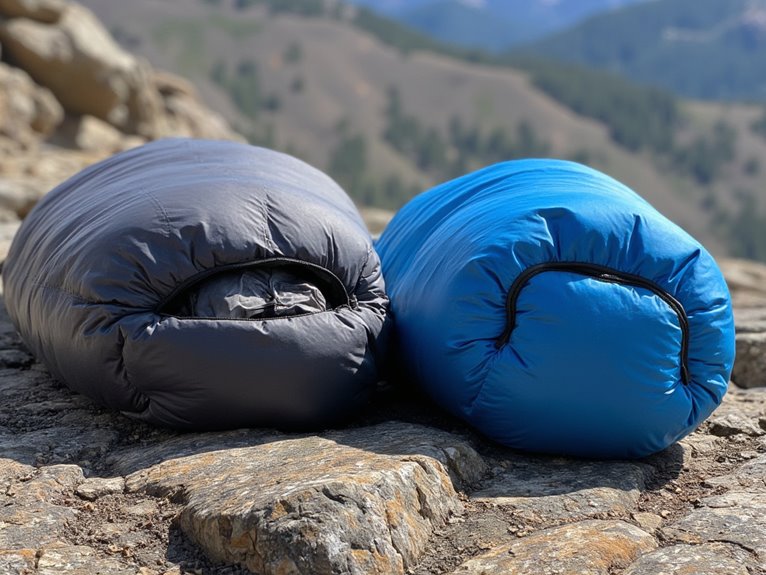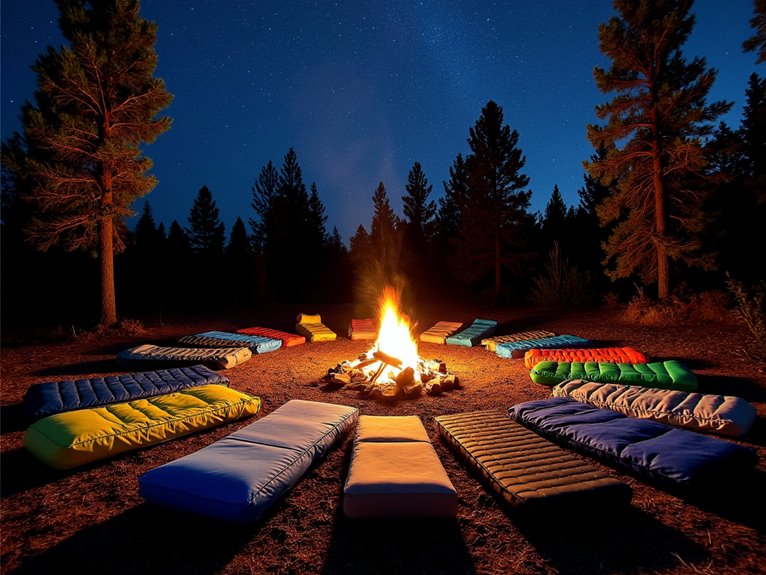What to Put Under a Sleeping Bag in a Tent?
When venturing into camping, what lies beneath your sleeping bag is vital for a restful night's sleep. Consider a sleeping pad for comfort and insulation, or an inflatable air mattress for a soft, cushioned surface. Insulating sleeping bag liners can boost the temperature rating of your sleeping bag, while extra clothing like thermal base layers and warm socks can keep you cozy on cold nights. A ground tarp can shield you from moisture, and DIY underlays can provide customized comfort. By choosing the right combination of these elements, you can guarantee a good night's sleep under the stars. Discover how to tailor your setup to suit your camping needs in the great outdoors.
We are supported by our audience. When you purchase through links on our site, we may earn an affiliate commission, at no extra cost for you. Learn more. Last update on 6th January 2026 / Images from Amazon Product Advertising API.
Sleeping Pads for Comfort
A sleeping pad provides an essential layer of comfort and insulation between the sleeper and the ground, making it a vital component of a restful night's sleep in the great outdoors.
It not only cushions the body from the hard and uneven ground but also helps retain body heat, keeping you warm on chilly nights.
Sleeping pads come in various thicknesses, materials, and R-values, which indicate their insulation capacity.
When choosing a sleeping pad, consider the temperature range you expect to encounter, your personal comfort level, and the weight and packed size of the pad.
A good sleeping pad can make all the difference in getting a good night's sleep while camping.
Inflatable Air Mattresses
Inflatable air mattresses offer a comfortable and compact alternative to traditional sleeping pads, providing a soft, cushioned surface that can be easily inflated and deflated for convenient transportation.
They are ideal for car campers and backpackers alike, as they provide excellent comfort without adding bulk to your gear.
Some benefits of inflatable air mattresses include:
- Lightweight and compact design for easy transportation
- Adjustable firmness to suit individual preferences
- Soft, cushioned surface for a restful night's sleep
Insulating Sleeping Bag Liners
Insulating sleeping bag liners provide an extra layer of warmth and comfort, effectively boosting the temperature rating of your sleeping bag while also protecting it from dirt and wear.
These liners are designed to fit snugly inside your sleeping bag, trapping warm air and keeping the cold out.
They are typically made of lightweight, breathable materials such as silk, cotton, or synthetic fabrics.
Insulating liners are especially useful for campers who frequently venture into cold climates or for those who tend to feel chilly at night.
Extra Clothing for Cold Nights
When facing extremely cold nights, extra clothing can be the key to a restful night's sleep.
In addition to a well-insulated sleeping bag, wearing the right clothing can make a significant difference in maintaining body heat.
Thermal base layers, insulating mid-layers, and warm socks are essential components of a cold-weather sleeping attire, and each plays a vital role in regulating body temperature.
Thermal Base Layers
One of the most effective ways to stay warm on a chilly night is to wear thermal base layers to bed, which can increase the overall warmth of your sleeping system.
Thermal base layers are designed to provide excellent moisture-wicking properties, drawing sweat away from your skin and allowing it to evaporate quickly. This helps regulate your body temperature, keeping you warm and dry throughout the night.
Some key considerations when choosing thermal base layers include:
Material: Opt for breathable, moisture-wicking fabrics like merino wool or synthetic blends.
Fit: Select a snug, comfortable fit that allows for a full range of motion.
Thickness: Choose a thickness suitable for the expected low temperature, with thicker layers for colder nights.
Insulating Mid-Layers
On frigid nights, an extra layer of breathable, moisture-wicking clothing, such as fleece jackets or sweaters, can be added on top of thermal base layers to provide additional warmth.
These insulating mid-layers help to trap warm air close to the body, reducing heat loss and keeping you cozy.
Look for materials with high loft and low weight, such as Polarguard or Thinsulate, which provide excellent insulation without adding bulk.
When choosing an insulating mid-layer, consider the activity level and temperature range you expect to encounter.
For extremely cold conditions, consider adding a second mid-layer or a down-filled jacket for extra warmth.
Warm Socks Essential
Cold feet can quickly drain the warmth from your entire body, making warm socks an essential component of a comfortable night's sleep in chilly conditions.
When the temperature drops, warm socks can be a game-changer. They help to maintain body heat, reducing heat loss and keeping you cozy throughout the night.
Some key considerations for warm socks include:
Material: Look for breathable, moisture-wicking materials like merino wool or synthetic fabrics.
Thickness: Thicker socks provide more insulation, but may be less comfortable.
Moisture management: Socks with moisture-wicking properties can help keep your feet dry and warm.
Ground Tarp for Wet Conditions
In wet conditions, a ground tarp is an essential layer of protection between the ground and your sleeping bag, shielding you from moisture and dampness that can disrupt a restful night's sleep.
This waterproof layer prevents ground moisture from seeping into your sleeping bag, keeping you dry and comfortable.
When choosing a ground tarp, look for a durable, waterproof material such as silicone-coated nylon or polyester.
Verify that the tarp is large enough to fit under your sleeping bag and tent, providing thorough protection.
Properly secure the tarp to the ground using stakes or rocks to prevent it from shifting or blowing away in windy conditions.
DIY Sleeping Bag Underlays
When creating a DIY sleeping bag underlay, it's essential to examine the materials used, as they can greatly impact the overall comfort and insulation of the setup.
The thickness of the underlay is also vital, as it needs to provide adequate cushioning without compromising the sleeping bag's ability to insulate.
Materials to Consider
A variety of materials can be used to create a DIY sleeping bag underlay, ranging from foam pads and inflatable air mattresses to camping mats and even old blankets.
When selecting a material, consider factors such as comfort, durability, and packability.
Foam pads are lightweight and compact, providing excellent insulation and can be cut to fit your sleeping bag.
Inflatable air mattresses are soft and comfortable, and can be inflated to desired firmness, but may be bulkier to pack.
Camping mats are thicker and more cushioned than foam pads, offering superior comfort, but may be heavier and less compact.
Underlay Thickness Matters
The thickness of a DIY sleeping bag underlay plays a crucial role in determining the level of comfort and insulation it provides.
A thicker underlay generally offers better insulation, but it also adds bulk and weight to your camping gear.
When deciding on the ideal thickness, consider the temperature range you expect to encounter during your camping trip.
For warmer conditions, a thinner underlay (around 1-2 inches) may suffice, while colder climates may require a thicker underlay (2-4 inches or more).
Additionally, the thickness of the underlay can affect the overall comfort level, as a thicker underlay can provide extra cushioning and support, which is essential for a restful night's sleep.
Insulation Options Abound
Foam sleeping pads, air-filled mattresses, and even repurposed materials like foam toppers or exercise mats can serve as effective DIY sleeping bag underlays, offering varying degrees of insulation and comfort.
When choosing a DIY underlay, consider the following factors:
- R-Value: Look for materials with a high R-value to provide adequate insulation.
- Thickness and Density: Thicker and denser materials provide better support and comfort.
- Moisture Resistance: Select materials that resist moisture to prevent heat loss and discomfort, thereby maintaining a comfortable sleeping temperature.




